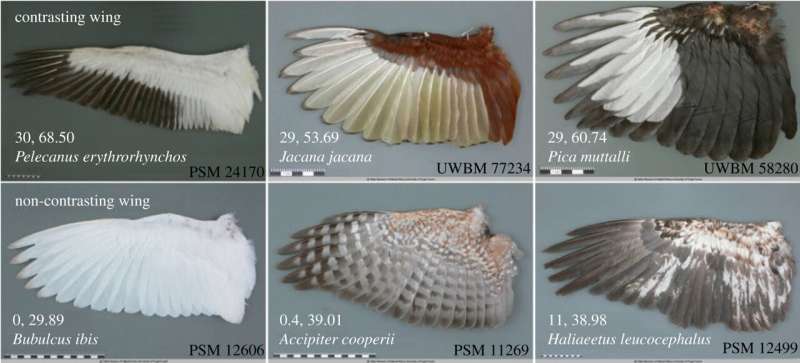July 6, 2022 report
Evidence found that colorful ventral wings help colonizing birds avoid collisions

A team of researchers affiliated with several institutions in China, the U.S. and Germany has found evidence that suggests that colorful ventral wings help colonizing birds to avoid running into one another. In their paper published in the journal Proceedings of the Royal Society B, the group describes comparing ventral wing colors from 1,780 bird species comprising 75% of orders.
Collision avoidance by birds living close to one another in colonies has not been deeply studied in the past. The researchers began their work by theorizing that birds living in colonies must have some means to avoid crashing into their neighbors because collisions between birds are dangerous for them. Any broken bones or sprains can prevent them from feeding, avoiding predators, nesting or taking care of their young. In this new effort, the researchers set out to determine what sort of avoidance mechanism the birds might be using. In studying imagery of colonizing birds, the researchers noted that most if not all of them seemed to have brighter ventral wings than non-colonizing birds. Ventral wings comprise the feathers located beneath the wings, near where they join to the body.
To find out if such wing coloring was indeed an avoidance feature, the researchers accessed a dataset of global bird information. In filtering for colonizing birds, they found a clear pattern. Birds that live in close proximity all have very clear and distinctive ventral wings. They also found that larger species, even those that do not colonize, also tend to have colorful ventral wings.
The researchers suggest the clear color patterns on the underwings of the birds helps individuals make out exactly where the other birds are flying, making it easier to avoid the same airspace. They also suggest larger birds have similar markings because they are less nimble flyers—they need more time to react when flying around others of their kind, which can happen during feeding forays.
More information: Kaidan Zheng et al, Contrasting coloured ventral wings are a visual collision avoidance signal in birds, Proceedings of the Royal Society B: Biological Sciences (2022). DOI: 10.1098/rspb.2022.0678
Journal information: Proceedings of the Royal Society B
© 2022 Science X Network



















